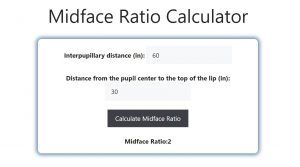About Midface Ratio Calculator (Formula)
The Midface Ratio Calculator is an important tool in the fields of cosmetic surgery, orthodontics, and facial aesthetics. It helps professionals assess facial proportions by comparing the interpupillary distance to the distance from the pupil center to the top of the lip. Understanding midface proportions is crucial for achieving balanced and harmonious facial aesthetics, whether for surgical planning, orthodontic treatment, or aesthetic evaluations. This article will discuss the formula for calculating the midface ratio, guide you on how to use the calculator, and provide practical examples.
Formula
The formula for calculating the midface ratio is Midface Ratio = Interpupillary Distance / Distance from Pupil Center to Top of the Lip. This ratio provides insights into facial proportions and helps guide aesthetic evaluations.
How to Use
To effectively use the Midface Ratio Calculator, follow these steps:
- Measure the interpupillary distance (the distance between the centers of the pupils) in millimeters.
- Measure the distance from the pupil center to the top of the lip in millimeters.
- Insert these values into the formula: Midface Ratio = Interpupillary Distance / Distance from Pupil Center to Top of the Lip.
- Calculate the midface ratio to assess facial proportions.
Example
Suppose the interpupillary distance is 60 mm, and the distance from the pupil center to the top of the lip is 30 mm. Using the formula:
- Interpupillary Distance = 60 mm
- Distance from Pupil Center to Top of the Lip = 30 mm
Calculating the midface ratio: Midface Ratio = 60 mm / 30 mm = 2
Thus, the midface ratio in this example is 2, indicating that the interpupillary distance is twice the distance from the pupil center to the top of the lip.

FAQs
- What is a Midface Ratio Calculator? A Midface Ratio Calculator is a tool used to evaluate facial proportions by comparing the interpupillary distance to the distance from the pupil center to the top of the lip.
- Why is the midface ratio important? The midface ratio is crucial for assessing facial balance and symmetry, which are key factors in aesthetic evaluations and treatments.
- What units are used in the midface ratio calculation? Measurements are typically taken in millimeters for precision in calculating the midface ratio.
- How do I measure interpupillary distance? Interpupillary distance can be measured using a ruler or a specialized caliper, ensuring the measurements are taken from the center of each pupil.
- How do I measure the distance from the pupil center to the top of the lip? Measure from the center of the pupil straight down to the top of the lip using a ruler or caliper.
- Can the midface ratio be used for all facial types? Yes, the midface ratio can be applied to any facial type and is useful for both evaluations and surgical planning.
- What does a higher midface ratio indicate? A higher midface ratio may suggest a longer midface, which could impact facial aesthetics and balance.
- Is the midface ratio relevant in orthodontics? Yes, orthodontists use the midface ratio to evaluate facial proportions and plan treatment accordingly.
- How can I improve my facial proportions? Consultation with cosmetic surgeons or orthodontists can provide options for enhancing facial proportions.
- What is considered an ideal midface ratio? Ideal midface ratios can vary based on individual preferences and cultural standards; however, ratios close to 1.5 to 2 are often considered aesthetically pleasing.
- Can the midface ratio help in diagnosing facial asymmetries? Yes, deviations from typical midface ratios can indicate facial asymmetries that may require corrective treatments.
- Is there a difference between midface ratio and facial index? Yes, the midface ratio specifically measures the midface region, while the facial index considers the overall proportions of the face.
- Can non-surgical treatments influence the midface ratio? Yes, non-surgical options like fillers can alter midface proportions and improve aesthetic balance.
- How often should midface ratios be evaluated? Regular evaluations may be necessary for patients undergoing orthodontic treatment or facial aesthetic procedures.
- Can this calculator be used for children? Yes, the midface ratio can be assessed in children to evaluate growth patterns and facial development.
- What are common applications of the midface ratio in aesthetics? Common applications include cosmetic surgery planning, orthodontic assessments, and facial rejuvenation treatments.
- Are there software tools for calculating the midface ratio? Yes, various software applications and online tools can automate the midface ratio calculation process.
- How do cultural perceptions affect midface ratio standards? Cultural standards for beauty vary, influencing what is considered an ideal midface ratio in different societies.
- Can I use the midface ratio for self-assessment? While self-assessment is possible, consulting with professionals is recommended for accurate evaluations and potential treatments.
- What are the limitations of using the midface ratio? The midface ratio is just one aspect of facial aesthetics and should be considered alongside other factors for comprehensive assessments.
Conclusion
The Midface Ratio Calculator is a valuable tool for evaluating facial proportions, particularly in fields like cosmetic surgery and orthodontics. By understanding and applying the midface ratio formula, professionals can assess aesthetic balance and plan effective treatments. Regular evaluations of midface ratios contribute to better outcomes in facial aesthetics, helping individuals achieve their desired look while enhancing overall facial harmony.